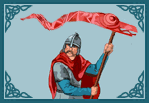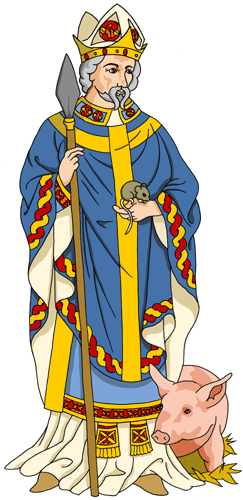 |
 |
|||
|
|
St. Cadog the Wise was one of the greatest of the Welsh Saints. He was the eldest son of King Gwynllyw Farfog (the Bearded) of Gwynllwg and his wife, Gwladys, born at Gwynllwgat Bochriwcarn in Gelligaer, around 497, and baptised "Cadfael" by St. Tathyw. At a young age he was sent away to be educated by this Irish saint at his monastery in Caerwent. Later, he left to become a wandering hermit in Penychen, the Kingdom of his uncle, Pawl. His presence was reported to the King by a swineherd whose pigs, Cadog had disturbed. King Pawl presented his nephew with the valley where these pigs fed, and here the young saint built his famous monastery of Llancarfan. Cadog stayed there for many years doing good works, but eventually he left for Ireland to study under Carthagh at Saighir. Cadog eventually returned to Wales with several Irish followers, including his great friend, St. Finnian, They settled at Llanspyddid by Y-Gaer in Brycheiniog where Cadog learnt Latin from an Italian mentor named Bachan. While at Llanspyddid, a great famine raged in the countryside around, but the Welshman saved his followers from starvation by observing a mouse which led him to a secret grain store. Eventually, Cadog's maternal grandfather, King Brychan Brycheiniog, gave him the church at Llanspyddid and the saint left Brachan there as Abbot while he moved on to Llangadog in Dyfed. Here he was constantly harassed by a local lord named Sawyl Penuchel (the Arrogant), whom some identify with the exiled King of the South Pennines. One day, while Cadog was out tending to the needs of the poor, Sawyl and his men raided Llangadog and stole all its provisions. Cadog had his revenge though. His monks pursued Sawyl's Warband, humiliated them by cutting off their hair while they slept and then enticed them into a marsh where they all drowned. St. Illtud, an officer of King Pawl of Penychen, was, similarly, converted to Christianity by Cadog when his men stole from the saint and were swallowed up by the earth! Cadog soon decided it was time to return to his original foundation at Llancarfan. He found the monastery in ruins and the monks all gone; however, Finnian and his fellows worked hard to restore the holy place for their friend. At this time, the ageing King Gwynllyw passed away and Cadog became monarch of his father's domain. He soon inherited Penychen too. The saint, however, did not allow his secular responsibilities to interfere with his holy way of life. St. Gildas was made Abbot of Lancarfan for a short while, when he visited Cadog there. The King-Abbot wished to travel North to spread the word of Christ, so left Gildas in charge. In return, the Northern saint asked his friend to found a monastery over the grave of his father, Caw, Sub-King of Cwm Cawlwyd, at Cambuslang. This Cadog gladly did. When he returned to Llancarfan, the two retired to the Bristol Channel. Cadog to Ynys-Barren (Barry Island) and Gildas to Ynys-Echni (Flatholm), though they often met up together for prayers. Gildas eventually moved on to Ynys-Witrin (Glastonbury) and Cadog, along with some of his entourage, appear to have travelled to Brittany, probably to escape plague in Wales. They stopped off in Kernow (Cornwall) on the way. Cadog visited his aunt, St. Keyne, on St. Michael's Mount and founded a chapel at Harlyn near Padstow. In Brittany, he settled on the Ile de St. Cadou in the Sea of Belz. While he was away, the Synod of Llandewi Brefi was held back in Wales, at which St. Dewi (David) was proclaimed Archbishop of Wales. Cadog was furious and relations with the monastics of Dyfed were soured for some time, until he eventually recognised Dewi's authority. While sojourning on the continent, Cadog made pilgrimages to both Rome and Jerusalem. Back in Wales once more, Cadog clashed with several of his fellow monarchs. As the country's High-King, Maelgwn of Gwynedd insisted on tribute from Gwynllwg and sent his officers to collect it. When these men kidnapped the daughter of Cadog's steward, however, they were pursued by the people of Gwynllwg and several were killed or injured. Maelgwn almost invaded Gwynllwg as a result, but Cadog was able to curb his temper. The warband of Maelgwn's son, Rhun Hir (the Tall), once burnt down Cadog's dairy and the young King was obliged to plead for forgiveness and make appropriate compensation. When Cadog's uncle, Rhain Dremrudd (Red-Faced), became King of Brycheiniog, he immediately took to asserting his power by raiding adjoining Kingdoms. Gwynllwg suffered along with the rest, but the locals managed to capture King Rhain and would have put him to death had his nephew not intervened. Around AD 564, the ageing St. Cadog caught the wanderlust again and spent some time revisiting Ireland. He later returned to Llancarfan, but quickly handed the monastery over to his disciple, Enlli. He then left for Beneventum, which is probably to be identified with Bannaventa in Calchfynedd (Norton in Northamptonshire) on the very edge of Saxon territory. Here he was elected Abbot of a large body of monks. The city was in ruins, but Cadog inspired the inhabitants to set about rebuilding it. In thanks, they created him their first Bishop. On 24th January AD 580, however, the place was invaded (by Saxons presumably) and Cadog was run through with a spear and killed in his own church. For many years the invaders would not let the British claim his body, but eventually he was transferred to Llancarfan where he now lies buried. His memorial may have found its way to Llandefaelog Fach, where a now lost stone was once to be seen inscribed with the name "Catvc". Having no heirs, Cadog had made arrangements for his Kingdoms to be left to King Meurig of Gwent, the husband of his young aunt. Records of St. Cadog date back to the 11th century. He is generally considered historic.
|
|||
| © Nash Ford Publishing 2001. All Rights Reserved. | ||||





 St. Cadog Ddoeth,
St. Cadog Ddoeth,